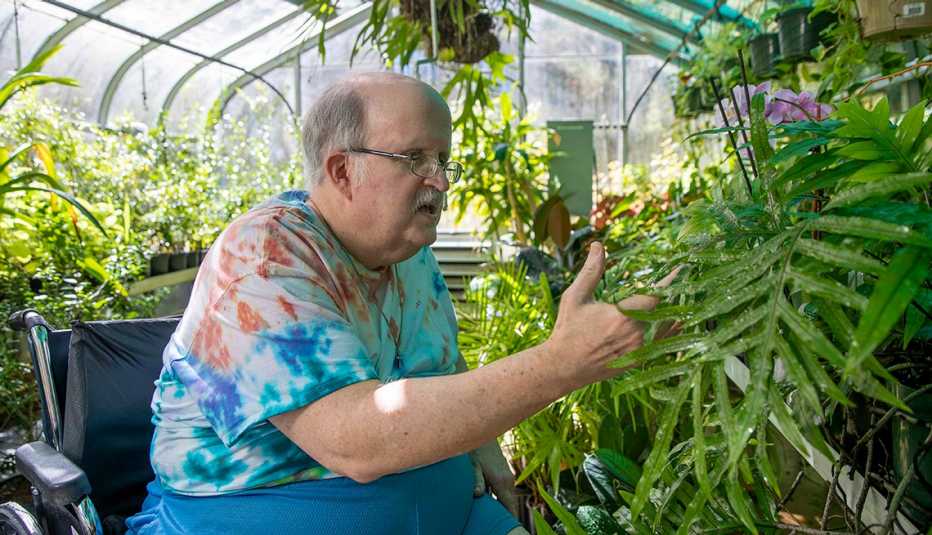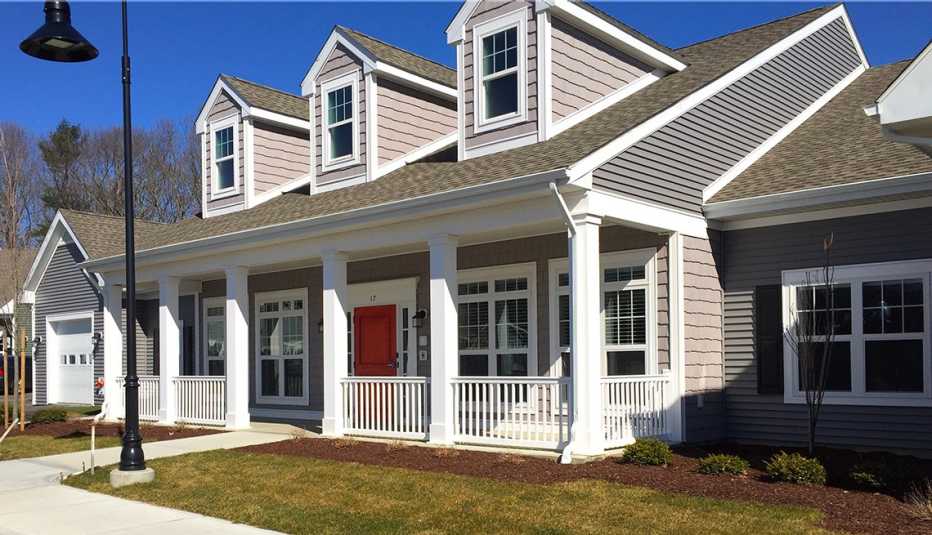AARP Hearing Center
David Waters can’t wait for the $37.5 million overhaul of his nursing home, in Cobb County, Georgia, to be finished. The project will bring a new therapy garden to the campus, where he’ll be able to work on his beloved jade succulents. “It’s gonna be gorgeous,” the 67-year-old, clad in a bright tie-dye T-shirt and surgical mask to protect from COVID-19, said in a recent Zoom call.
Fellow resident Carolyn Gibson, 83, also on the call, heard that the new common areas have been designed by a residential architect to resemble living rooms. “That just sounds wonderful,” she said, nodding, her big gold earrings waving to and fro.
But there’s one change coming to the 130-bed A.G. Rhodes senior care facility, just outside of Atlanta, that lights up residents’ eyes like no other: private rooms. When construction is finished later this year, the facility’s shared two-bedrooms will be replaced by 58 private rooms. And a brand-new building will boast 72 more private rooms for memory care patients.
Shared rooms will be relics of the past.
“The privacy – I’d just love that,” says Gibson, who currently has a roommate. “I could turn up my television as loud as I want, put things on the walls … I would just be able to make it my own little cocoon.”
“One person per room?” says Waters, who also has a roommate. “Sign me up!”


It’s a feeling shared by many of the nation’s 1.2 million nursing home residents and their loved ones, especially after the COVID-19 pandemic. The virus has killed more than 163,000 nursing home residents, according to government data – likely an undercount. Shared rooms helped enable COVID’s wildfire-like spread through the facilities.
As a result, private rooms for residents are part of President Joe Biden’s sweeping plan to improve the nation’s 15,000 nursing homes, announced early last year. A growing body of evidence shows that private rooms not only help prevent infections from spreading, but that they also lead to better overall health and satisfaction among residents. Biden’s plan instructs the federal government to explore “ways to accelerate phasing out rooms with three or more residents and to promote single-occupancy rooms.”
But implementing such a vision could take decades, if it happens at all. Most U.S. nursing home residents currently live in shared rooms, with two to four residents and a shared bathroom. So while some nursing homes, like the nonprofit A.G. Rhodes, are helping deliver on Biden’s goal, many in the industry say widespread adoption of private rooms would require huge shifts in how facilities are configured, financed, regulated and run. Nursing home operators, resident advocates and industry experts say the federal government would need to do much more to drive a revolution in how residents are housed.
“Our nursing home model doesn’t support private rooms at all right now,” says Sheryl Zimmerman, co-director of the University of North Carolina at Chapel Hill’s Program on Aging, Disability and Long-Term Care. “Radical changes are going to have to happen if we want to see more.”
Old buildings, outdated care
After World War II, a law known as the Hill-Burton Act transformed the nation’s senior housing from small privately run dwellings into highly medicalized facilities that resembled hospitals. The new nursing homes were regulated and largely funded by the government. And the focus, many industry experts say, shifted from welfare to health care.
As demand for senior care boomed over the following decades, thousands of large chain-operated nursing homes with hundreds of beds cropped up. Picture multi-story buildings, long hallways, lots of medical equipment, drug carts, commercial cafeterias — and shared rooms. Such facilities are still the norm today, with more than half of the nation’s current nursing homes built before 1980.
But new ideas about personalized and homey nursing home care took root in the ’80s, as resident advocates pushed for more of a balance between clinical care and quality of life. New long-term care models promoting person-centered care and home-like settings emerged.
The Green House Project, for example, was founded in the early 2000s to create “radically noninstitutional eldercare environments.” The not-for-profit has since built more than 350 homes around the country.
Each Green House “household” accommodates no more than 12 residents, and everyone gets a private bedroom and bathroom. Communal spaces add to the hominess. Picture a residential-style kitchen, an open-plan dining area with a large table, a central lounge with a fireplace and accessible outdoor spaces like porches and courtyards. Pets are welcome.


The Green House project encourages autonomy and self-sufficiency among its residents, known as “elders.” Those qualities can be hard to find in traditional nursing homes. Elders can access the household’s pantry and housekeeping closets without having to ask permission. In traditional nursing homes, such access is often only granted to staff. Green House elders can also assist staff in planning, preparing or cooking meals. In most nursing homes, residents are barred from big commercial kitchens because they’re unsafe.
The more residential-style settings tend to yield better results than traditional nursing homes. Residents of Green Houses — the most widely studied of the smaller-house models — have lower rates of rehospitalization, are 45 percent less likely to need catheters and are 16 percent less likely to be bedridden. Other studies show higher quality of life, lower medical costs and reduced staff turnover.


































































